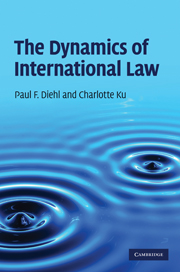Book contents
- Frontmatter
- Contents
- Acknowledgements
- 1 Introduction
- 2 A new framework for analysis and a model for legal change
- 3 The influence of normative change on the operating system
- 4 Extra-systemic adaptations to systemic imbalance
- 5 The influence of the operating system on normative change
- 6 Implications and future directions
- References
- Index
2 - A new framework for analysis and a model for legal change
Published online by Cambridge University Press: 02 December 2010
- Frontmatter
- Contents
- Acknowledgements
- 1 Introduction
- 2 A new framework for analysis and a model for legal change
- 3 The influence of normative change on the operating system
- 4 Extra-systemic adaptations to systemic imbalance
- 5 The influence of the operating system on normative change
- 6 Implications and future directions
- References
- Index
Summary
In the previous chapter, we reviewed a broad range of different frameworks over a long time period for the study of international law. Most, if not all, were static and descriptive, incapable of accounting for legal evolution and adaptation in the global arena. In this chapter, we develop our own theoretical framework for capturing this behavior and understanding international law. The heart of that approach is the bifurcation of international law into two subsystems, the operating and normative systems. The sections below describe those systems in detail as well as specifying their functions. We then briefly discuss how, and in what ways, those systems have expanded over the history of modern state relations, with an emphasis on more contemporary changes.
Our theoretical framework specifying the operating and normative systems permits us and others to address questions of change. Yet the framework itself, and indeed any framework per se, does not provide the answers to those questions. To achieve this, we must spell out a theory of how the two systems interact. Thus, the second part of the chapter provides the theoretical conception of how these systems influence each other. This is the basis for the precise elucidation of the conditions and forms associated with system changes that are examined in Chapters 3–5.
The operating system
The dual character of international law results from its Westphalian legacy in which law functions between, rather than above, states and in which the states carry out the legislative, judicial, and executive functions that in domestic legal systems are performed by separate institutions.
- Type
- Chapter
- Information
- The Dynamics of International Law , pp. 28 - 73Publisher: Cambridge University PressPrint publication year: 2010



